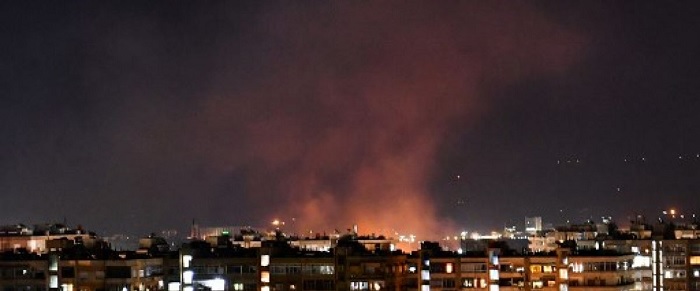
In the early morning of September 11, Syrian air defenses were suddenly activated; moments later, a series of strikes leveled two buildings in a compound of nondescript, gray concrete structures just south of Aleppo city in northern Syria.
The target of the strikes was al-Safirah military complex, a munitions factory and storage facility that Syria has used since 2001 to produce and store ballistic missiles and chemical weapons.
The strikes—the second time the facility has been struck this year—were most likely conducted by Israel, which, in the words of former Israeli Defense Minister Naftali Bennet in late April, has recently adopted a more aggressive posture on Syria to “force [Iran] out of Syria.”
Though Israel follows a policy of not claiming responsibility for airstrikes in order to allow its targets to save face, Syria Direct has documented at least 16 separate strikes most probably conducted by Israel on at least 22 different locations in Syria from January 1 to September 15, 2020. In collecting data, an airstrike was defined as a military operation conducted by aircraft, so multiple targets could have been hit within the same airstrike.
It is worth noting that the true number of strikes is likely higher, as evidenced by the outgoing head of the Israeli Defense Forces (IDF) Gadi Eisenkot in January 2019, who claimed that Israel had conducted “thousands of strikes” in Syria during his tenure from 2015 to 2019 without claiming credit for them. In addition, not all locations of strikes are publicly known.
The UK-based Syrian Observatory for Human Rights (SOHR) also claims the number of strikes in 2020 to be higher: 30 as of September 12. However, there have been several instances where SOHR reported strikes that cannot be verified or are found to be erroneous after satellite analysis of the purported strike areas.
The majority of unverifiable reports by SOHR of Israeli airstrikes allegedly took place in Deir e-Zor, specifically around the Albukamel border crossing with Iraq, which is controlled by Iranian-backed forces and Hezbollah. If these strikes did in fact occur, it is also possible that they were conducted by the US or US-led international coalition forces; however, a lack of third-party sources reporting on these strikes means they cannot be confirmed.
Syrian state media regularly claims that its anti-air defense systems intercept the incoming Israeli strikes, but that is largely considered to be mere bluster. In the past two years, Syrian air-defense systems have twice missed Israeli missiles and instead landed in Cyprus and northern Jordan.
Strikes mainly hit Iranian munition sites
According to strike data, nearly two-thirds of Israeli airstrikes this year targeted weapons depots which either had recently received weapons shipments from Iran or were holding Iranian munitions.
This largely follows Israel’s stated goals in Syria: To prevent a buildup of Iranian forces or bases near the Israeli border, and to disrupt the so-called land bridge through which Iran sends weapons and equipment to Hezbollah in Lebanon.
In the case of al-Safirah military complex—which Israel first struck on May 4, then again on September 11— the base was known to carry various Soviet-made SCUD ballistic missiles. One of the missiles held at the base, the SCUD-D, has a range of 700 kilometers, sufficient to strike Tel Aviv from Aleppo.
The base also was alleged to have been involved in the production of chemical weapons, which Israel fears could be transferred into Hezbollah’s hands. On the day after targeting al-Safirah, Israel also hit the Scientific Studies and Research Center in Aleppo, another facility notorious for its production of chemical weapons.
Israel also struck the vicinity of the Damascus International Airport twice, on February 13 and August 31. The strikes are believed to have both targeted Iranian weapons storage facilities, but the latter of the two strikes carried renewed meaning as Israel sought to deter Tehran from following through on its promise to upgrade Damascus’s air defenses.
There was also a large concentration of strikes in southeastern Syria, on groupings of Lebanese Hezbollah, as well as on Syrian army positions in the Golan—in one case, after Syrian forces fired over the border.
Israel had previously said that it would not accept the presence of Iranian-backed forces or Lebanese Hezbollah within 60 km of its border; however, since the regime retook southern Syria in July 2018, Iranian forces have steadily strengthened their presence in the area.
According to a June 2019 study by Elizabeth Tsurkov, Russian and US reluctance to address the Iranian presence in the south led Israel to adopt a more aggressive posture in Syria.
 Eurasia Press & News
Eurasia Press & News



